
The following is part of Now Loading, a series that renders verdicts on whether or not your favorite video games deserve a place in the canon of works that have contributed to video-game storytelling in landmark ways. Read the series’ full mission statement here.
A Less Than Terrible Fate
Ladies and gentlemen, boys and girls, if you don’t start behaving yourselves, I will turn this online column around, just see if I don’t, hello and welcome to this week’s installment of Now Loading…The Video Game Canon! The only weekly Internet column that takes a moderately deep look at old video games and decides whether they should be remembered for all time. This week, we will be looking at Nintendo’s classic 1998 game, The Legend of Zelda: Ocarina of Time. And look, folks, in the interest of transparency, I’m just going to go ahead and tell you all right now that this game makes it into the canon. I grant you it’d be an upset of major proportions for a contributor on this site to speak ill of Ocarina of Time, and I’m not in the business of upsetting people. I’m in the online analysis of video games business, and I’ll be damned if I upset anyone with my thoughts and opinions. That being said, Ocarina of Time is of course deserving of a place in the canon, without a doubt. The presentation of its engaging story alone is what gives it unfettered access to the halls of history in my mind, but to stop at its narrative accomplishments alone would be to do a disservice to a game that truly exemplifies what it means to put yourself in the place of a fairytale hero. Now I realize that I may have sucked all the suspense out of this article for you by giving away the verdict, but if you stick around I promise you at least one or two insights that will make you say, “All right, that article turned out to be spiritually, intellectually, and emotionally fulfilling.” So, you know, do stick around, won’t you?
The Legend of Zelda: Ocarina of Time was developed by Nintendo and released in November, 1998 as a flagship title not only for the Nintendo 64, but also for Nintendo’s 3D games in general. While the Nintendo 64 had been exalted for its 3D capabilities with the release of Super Mario 64 a few years earlier, it wasn’t until the release of Ocarina of Time that it became clear that 3D games were not just a gimmick, and that Nintendo was able to tell fully realized, cinematic stories via their games thanks to the power of the Nintendo 64. Not only were the characters and environments visually impressive, but the use of Navi and the Z-targeting system also exemplified how 3D action/adventure games could be designed. Ocarina of Time slowly built up a massive fanbase which soon eclipsed not only other N64 titles, but also other titles in the Legend of Zelda video game franchise. Soon Ocarina of Time became synonymous with The Legend of Zelda, and as far as I’m concerned, that acclaim is more than well-deserved.
I can tell you about its acclaim until the Lon Lon Ranch’s cows come home, but that wouldn’t be a very compelling read, now would it? Without further ado, let’s take a look at The Legend of Zelda: Ocarina of Time.

Story and Characters: The Monomyth in Video Game Form
In my last semester of high school, I was given the opportunity to design my own course around whatever I wanted, and what I wanted, unsurprisingly, was to take an in-depth look at certain video games and discuss their artistic merits. Over the course of three months, I looked at four games in total, but when it came to choose which game I wanted to publicly discuss as the best example of visual, interactive storytelling, I chose Ocarina of Time. This was an obvious choice for one undeniable reason: The Legend of Zelda: Ocarina of Time is the perfect example of Joseph Campbell’s monomyth. For those of you who don’t know, the monomyth is the idea that each and every story ever told throughout human history essentially follows the same basic path, which Joseph Campbell referred to as “the hero’s journey.” He explains this idea in excruciating detail in his work, The Hero with a Thousand Faces; boiled down to its essentials, the hero’s journey is shorthand for how a story is structured and progresses as it is being told. A famous example of a storyteller using Campbell’s model to write a story is George Lucas and Star Wars, but since this is a column about video games, let’s see how Ocarina of Time uses the monomyth formula to tell a brilliant, interactive narrative, in which the player becomes a hero just as much as Link does.
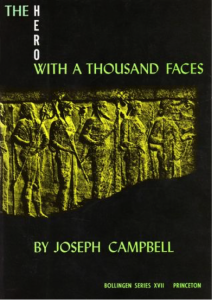
A thousand, five, who’s counting?
Campbell’s monomyth, like the story of Ocarina of Time, begins with a character in a place of comfort and familiarity. For our avatar, Link, this place is his home in the Kokiri forest, where he has grown up for the past eight years or so. While this place feels like home to Link, it is clear that there is some recurring, nagging thought that tells him he doesn’t actually belong there. This manifests in two ways;:one, he has dreams every night about a dark storm and an evil man on the horizon; and two, he does not yet have a fairy companion, and the Kokiri see these companions as a sign of maturity and belonging. Link is set up as an outcast from the very beginning, and although the forest is familiar to him, we slowly realize that he does not truly belong there. So before the story truly starts, we get the distinct impression that there is something special about Link. This is proven to us when the Great Deku Tree sends the fairy Navi to Link in what Campbell refers to as “the call to adventure.” Some outside force—in this case, the Great Deku Tree—calls upon our hero to leave his comfort zone and take part in a life-changing experience. Link accepts this call to adventure, and is given Navi as his friendly guide, or “supernatural aid.”
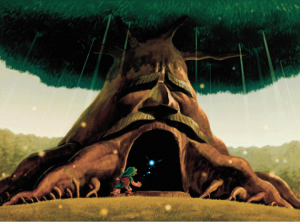
“I’m about to lay some pretty heavy stuff on you, bro.”
After accepting this journey, Link attempts to leave his comfort zone, but is met by his old friend Saria. Saria is glad that Link finally has a fairy companion like all the other Kokiri, but she realizes that he is still different from the rest of them. Not wanting to lose a friend, however, she briefly asks him if leaving the forest is what he really wants; after a moment of hesitation, Link accepts her parting gift (a wooden ocarina) and runs out of Kokiri forest, not looking back. Before entering the vast Hyrule field area, Link is met with Kaepora Gaebora, an old owl who stops you and briefly informs you of the dangers that lie ahead of you on your journey. After cycling through his warnings, you are free to explore the massive expanse that is Hyrule. Saria and Kaepora Gaebora are what Campbell refers to as “threshold guardians,” forces from the world before the journey that try to keep the hero in that comfort zone. Whether through malicious intent or not, these characters serve as a first test to the hero; if the hero passes this first step, then the story can continue moving forward. These two guardians give Link—and, by extension, the player—the option to either press onward or remain in that comfort zone, never to progress.
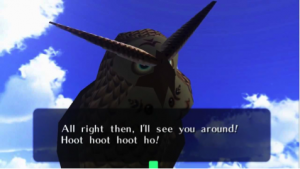
I bet you will, sir. I bet you will.
After traversing Hyrule field and entering the castle town of Hyrule, Link sneaks into the castle and has the “meeting with the goddess” moment upon meeting Princess Zelda. Up to this point in the story, your motivation for leaving the comfort zone was a vague notion that evil was coming, and it was up to you to stop it. The meeting with Princess Zelda not only gives us some context for that coming evil, but also a more focused direction for how to stop it. Zelda tells us that Ganondorf, this shady man about whom Link has been having nightmares, is trying to break into the Temple of Time and take over the land of Hyrule. To stop him, Link must get the three Sacred Stones that open the Temple before Ganondorf does. Of course Link agrees, and the next portion of the game is devoted to traveling to different areas of Hyrule, meeting different races of people, befriending them, and then collecting these stones to stop the evil Ganondorf. All of this falls into the seemingly cheating category of “trials and tribulations,” but we’ll give old Josey Cams a pass on that one.
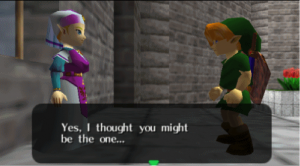
You’re Luke, right? Link. Works for me.
Despite your heroic efforts across the land of Hyrule collecting the Sacred Stones, Ganondorf still rises up in a cloud of evil and tries to steal the titular Ocarina of Time, which, along with the Stones is a key component in opening the Temple of Time. In a wild escape from Hyrule Castle, young Princess Zelda throws the Ocarina to Link, telling him to open the Temple of Time and save it from Ganondorf. Of course, with both Link and Zelda being young and naïve, they end up playing right into Ganondorf’s hands: when Link opens the door to the Temple of Time, Ganondorf swoops in and gains access to the Sacred Realm, corrupting the mythical Triforce and gaining the power to take over Hyrule. It seems that your actions have doomed the world; but fear not, young hero, for the fates have other plans.
Link awakens seven years later as a young man, and is told by an old sage that his actions have led to Ganondorf’s domination of Hyrule. Bummer. And yet, by gathering the power of five other sages across Hyrule, Link will be able to seal Ganondorf away and save the world. More trials and tribulations happen, you meet old friends along the way who inevitably become the sages, and you grow in both heroism and courage as you fight your way through monsters and intuit your way through countless brainteasing puzzles. It is through this second portion of the adventure as an “adult” that you truly come to understand what being a hero means: that it’s not a playtime kid’s adventure, but rather a constant struggle with consequences and peoples lives and futures on the line. You see firsthand the power of oppression, fear, and evil, and through nothing but your own courage and the help of others, you come to understand how much more power lies in compassion and selflessness as compared to pure, unbridled hate and ambition. Link begins as a child and is forced into an adult body, and must come to terms with what it means to be a hero for the sake of those around him. In this way, and in many others (including a literal swordfight with Link’s dark reflection) Link and the player, undergo what Campbell calls “death and rebirth.” By letting go of the past and your preconceived notions of heroism and accepting what it means to be a true, adult hero, you are no longer the young boy who left the forest: now, you are the Hero of Time you were destined to become.
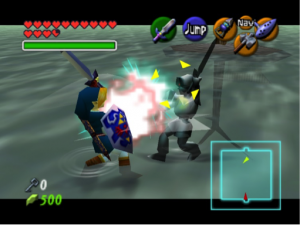
Stab not at the abyss: the abyss will also stab at thee.
Eventually, of course, Link gathers the power of the sages and defeats Ganondorf with the help of Princess Zelda, and all is right with the world of Hyrule. The people are saved, the King of Evil is defeated, and now you can go back in time to the point where Link and Zelda meet to stop this horrible future from ever happening. After Ganondorf’s defeat, Zelda thanks Link for his efforts and sends him back in time to his childhood, effectively erasing all his heroic deeds from the minds of everyone except for Link himself.
So, having gone through all that, you may be asking yourself, “all right, sure, but what’s the point? If every story follows these basic guidelines, then what’s so special about Ocarina of Time?” Well, my thoughtful reader, there are a few reasons. First and perhaps most importantly, Ocarina of Time is not only merely example of the monomyth: it’s a near perfect example of it. Chalk it up on the board next to the original Star Wars, because there is not an ounce of fat in the storytelling of this game. Each and every character serves a meaningful purpose to the overall story, and you truly believe that Link is a changed person by the end of it. Why do you feel this so palpably, you may continue to ask? Well, that’s because of the second reason for this game’s brilliance: YOU are the hero. YOU go on this journey. Because Link is a silent protagonist whose only real defining characteristic is “courage,” you perfectly embody him as he goes on his journey. You, the player, are the one courageous enough to leave Kokiri forest, you are the one brave enough to face the monsters, and you are the one with enough strength of mind and fortitude of will to navigate the dungeons, cross the fields of Hyrule, and save those who have become important to you. The Legend of Zelda: Ocarina of Time does perfectly what so many games only hope to achieve. Ocarina of Time makes its player into a true hero.
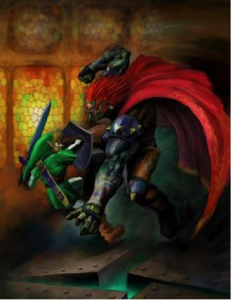
Gameplay, Music, and Visuals: A World as Immersive as the Story
There is not much to say here that I didn’t already tangentially cover in the previous section, so I will be as brief as my gushing mind allows me. Fret not, faithful reader! It will be as concise as a man who’s clearly in love with this game can be. When it comes to the gameplay of Ocarina of Time, I would say that it hasn’t aged quite as gracefully as the game’s story and characters. Though Link’s attacks have heft and weight to them, once you pick up on the rhythms of the game, battles become less of a strategic challenge and more of a waiting game. Granted, that could be said about most games when you become used to their controls, but Ocarina of Time tends to suffer from a “waiting around” syndrome that a lot of these early 3D games had. 2D platformers and action/adventure games have the benefit of being limited by two dimensions, so your actions in those dimensions are simple and precise. Jump, swing, slash, and what have you. Once you add that third dimension in there, though, you have to contend with rolling, blocking, strafing, lunging, and all other manner of hop-about movements that have the potential to add much more excitement to a fight, but tend to result in learning a very specific pattern and striking when the game decides to give you an opportunity. I would say that varied and interesting boss fights make up for this, but they also suffer from the problem of predictability based on the item you found earlier on in that boss’s dungeon. There have been plenty of people online who’ve complained about the “find an item, use an item, kill the boss” formula that Zelda has, so I won’t go too much further into it here. In my opinion, the gameplay of Ocarina of Time is very interesting, just not necessarily when it comes to sword fighting.
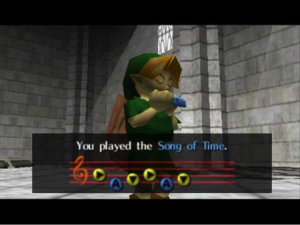
The part of the gameplay that I find most amusing is deeply intertwined with the wonderful music that this game has. Throughout the game, you use the eponymous Ocarina of Time to play a number of different songs that progress the story. Some warp you to different locations, some change the weather or time of day, and others, like “Zelda’s Lullaby,” are necessary for solving certain puzzles along the way. Not to mention the “Song of Time,” which allows you to move backwards and forwards through time as you see fit to solve puzzles and manipulate certain other aspects of the game. Music is so integral to The Legend of Zelda as a franchise, and having a game mechanic that allows you to control music does more to immerse you into the world of the game than fighting the monsters ever does. Not to mention that the music in general is brilliant, and Koji Kondo once again knocks it out of the park with his compositions for this game.
And finally we come to the visuals of the game, which, like those of Final Fantasy VII, are a product of the polygonal time from which it came. The character models are a little sharp and choppy at points, but, unlike FFVII, Ocarina of Time has something of a timeless quality in its design because its design is more cartoonish. Nintendo excels in art design for their games, and their Disney-esque, cartoony character models help to make them age well in spite of graphic limitations. The character models are memorable, and the environments themselves are still pretty breathtaking today. From the moment you step outside Kokiri forest, you feel how vast the expanse of Hyrule is, and being able to explore it makes it that much more interesting. Though a bit limited by today’s standards, Ocarina of Time’s visuals are as stunning now as they ever were.
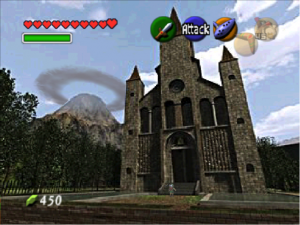
I betcha there’s some mighty fine adventurin’ to be had through that ol’ Gothic doorway, I tell you what.
Impact on Video Gaming and Culture: Unfathomable Depths of Impact
Well, let’s see. Not only is it still the Legend of Zelda title against which all other entries into the series are judged, but it’s also a game to which all other action/adventure role-playing games are compared to this day. It holds the Guinness World Record for most highly reviewed game of all time, and when talking about this game with video game enthusiasts you can practically see the nostalgia dripping off them. It changed the gaming landscape when it came to cinematic and interactive storytelling in games, had a completely remastered remake nearly break 3DS sales—and, oh yeah, you’re reading this article on a website that began by strictly analyzing the mind-bogglingly amazing sequel to this already incredible game. The Legend of Zelda: Ocarina of Time is to video games what Citizen Kane is to cinema.
BONUS LEVEL: Horse With No Name
I think at this point my opinion on this game is fairly clear, but let me take a moment in the Bonus Level section to describe a sequence in this game that very nearly brings me to tears for how perfectly it summarizes what I see as the moral of this game. Once you have defeated Ganondorf, Zelda and Link reunite and briefly discuss all that has happened to this point. Zelda, in her wisdom, expresses deep remorse for her actions as a child that inevitably led to Ganondorf’s rise to power in the first place. Although she is overjoyed that Link has saved Hyrule, she knows that the truly right thing to do is to send him back to his childhood in the hopes that he can prevent her younger self from being so foolish in the first place. Link nods in silence, and with deep gratitude for all that he has done, Zelda sends him back in time.
We then cut to the denizens of the now free Hyrule cheering in a parade celebrating their release from the King of Evil. Everyone Link has met on his journey through the decimated Hyrule is dancing and laughing, lauding the hero who broke them free from the hell that was Ganondorf’s tyrannical rule. We see pure gratitude and exaltation from the crowd as we pan away from them to see the sages, the six people who knew Link best, watch as the people have a party for the man who isn’t there.
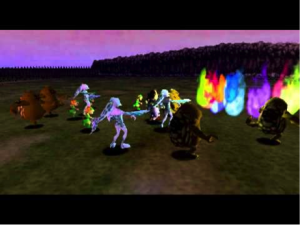
The Temple of Time fills with blue light, presumably for the last time, as Link and Navi return home. Now a young boy again, Link looks to Navi and watches as she flies up above him and out the temple window—her mission, like Link’s is complete. Seeing Navi—his one friend who has been on the journey with him from the beginning, the only symbol of belonging he has ever had, and the last remaining tether to his origin as a boy from the Kokiri forest—leave him, Link looks towards the exit and leaves to find Zelda. We end on Link, now a changed person, meeting with Zelda again, hopefully to warn her of her actions and prevent the horrible future where Ganondorf rules, where Link ultimately became a hero, from ever existing.
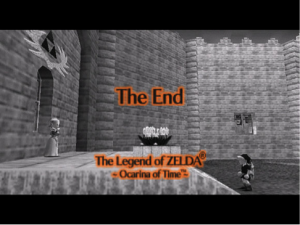
Let’s not muck up eternity too much this time, eh?
Link does not see his parade. He does not witness the immense gratitude the people of Hyrule have for his bravery. He loses his one true companion, and in so doing has cut all ties to the world from which he came. Link’s sole reward is knowing that he saved the world, and that he made people safe, because a true hero does the right thing even when no one knows he’s done it.
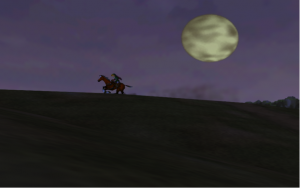
VERDICT: I Mean, of Course
The Legend of Zelda: Ocarina of Time doesn’t just deserve a place in the canon: it may very well be the reason I began this series in the first place. It is such a great example of visual and interactive storytelling that I truly believe it should be studied by anyone who wants to make video games for a living. Hell, this game should be studied by anyone who wants to be an artist, composer, writer, or even just a better person. The story is so flawlessly executed and makes the player feel as if there is no distance between him and the main character at all. The beautiful music, engaging environments, and overall immersive world does wonders to suck the player in and make them feel as if they were truly fighting for the salvation of Hyrule. And trust me, I know how fun it is to take something seen by everyone as a classic and nitpick the hell out of it, but Ocarina of Time needs to be placed above that. The gameplay is a bit wonky at times, and the character designs may be a bit pointier than we’d like in this day and age, but the themes and brilliant storytelling elevate this game far beyond many of its contemporaries—and beyond a fair number of modern games, too. Play the game. Become a hero.
So welcome, The Legend of Zelda: Ocarina of Time, to the video game canon. And in the words of each and every incarnation of Zelda, “Thank you, Link.”
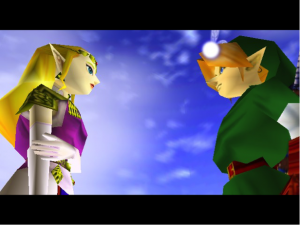
Well done, hero.



